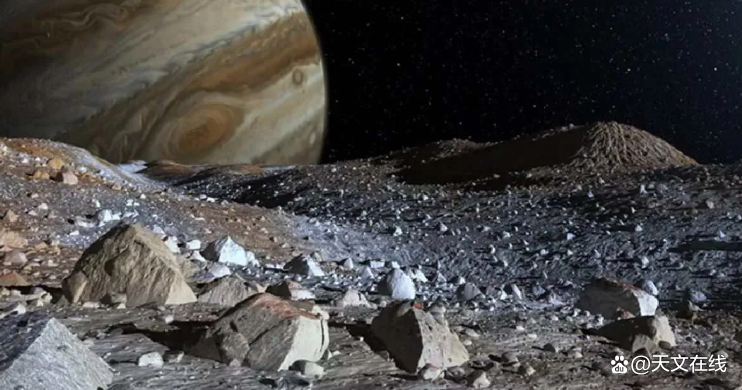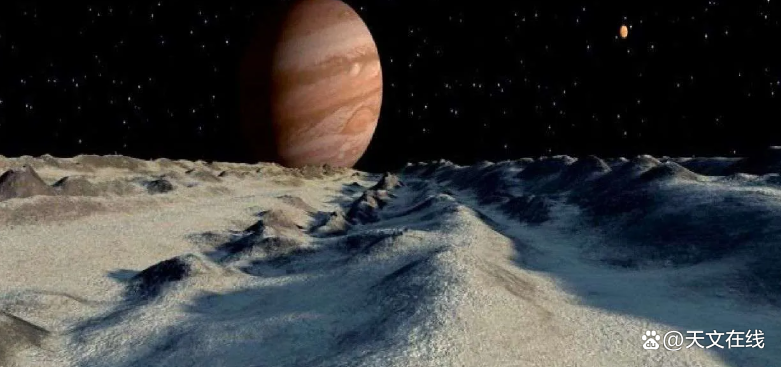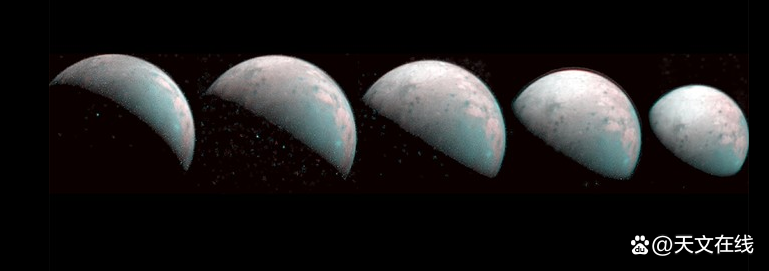Kibu Er, Jupiter’s satellite, this is the frozen place above it
Author:Astronomy online Time:2022.07.13
A NASA aircraft recently observed the Jupiter's cold satellite Jupiter II of the North Pole for the first time
When the camera of the aircraft is approaching and amplifying Muwei II next year, this distant image will become clearer.
Mu Wei Er Junuo

The Juno spacecraft captured the North Pole area of Muwei Er for the first time. NASA officials said that this was the first image of this area they harvested, and future flights will provide clearer observations. (Picture source: NASA/SWRI/MSSS/Andrea Luck)
We finally learned what Jupiter's satellite Jimbu's North Pole looks like, although the distance is far away.

The remote picture taken by this NASA Juno spacecraft captured a area that Muwei Er had never seen before. In this area, there is obviously water vapor rising from the feathers and may mean a resident environment in its ocean.
This picture was taken at a place nearly 50,000 miles (80,000 kilometers). At that time, Juno was performing its primary task to observe the Jupiter atmosphere. It is true that this picture has a low clarity, and each individual pixel is rendered from about 31 to 37 miles (50 to 60 kilometers). But you can see changes in the anti -photo rate, on a brighter satellite in general.

When the distance of the aircraft camera next year is shortened to a place with only a few hundred miles above satellites, the clarity of the picture will improve, and Jino's main investigator Scott Bolton will be held on NASA on Thursday (October 28). The media meeting said.
"This is an extremely attractive example and preview of the future," Bolton said that he is the director of the Southwest Institute (SWRI) Space Science and Engineering Branch. The result of Mu Weiji was briefly mentioned in a greater discussion. This discussion was a deep basis for the 3D perspective of Jupiter's atmosphere and the continuous peak of the continuous peak of Great Red Spot.
Mu Wei is a popular destination that is often shot by aircraft. The first group of near -scene images came from the Gemini Pioneer and Polish Seasons in the 1970s of NASA in the 1970s. These pictures revealed a cracks frozen surface. Between 1995 and 2003, more details were discovered in the process of being responsible for the mission of Jupiter and its satellites.

Many aircraft passed Muwei Er during the flight to other destinations. The Hubble Space Telescope and other telescopes located on the earth or other telescopes will shift their sights to Muwei Er every other time. But what limits these different perspectives is that these telescopes are close to or on the zodiac. The solar, planets, and many satellites in the solar system surround the zodiac surface.
Conversely, Juno has a more orbit centered on the sun. It has provided some unique images of Jupiter, such as the amplitude and stability of Jupiter's sun whirlwind. Mu Weiji's photo was made by a citizen scientist Andreia Lark's information from Junocum camera.

The media meeting did not discuss what science may be performed in Muwei Er's two poles, but the previous peer review research has discussed the transient water vapor that appeared in Antarctica or trying geological surveying and mapping at the same time as closer to the pole.
In the second stage of this decade, at least two main tasks are expected to launch to Muwei. Jupiter's Jupiter Ice Protocolic Explorer (JUICE) will be launched in June 2022, and during the flight, it will pass Muwei Er and several other ice quality worlds. At the same time, NASA's Muwei Two Ship will follow its satellites after launch in October 2024.
Two tasks will arrive at Mu Weiji after 2030 and work there.

related information
Muwei Er, also known as "Muwei II", is one of Jupiter's natural satellites. It was discovered by Galileo in 1610. It was the smallest of the four Galileo satellites. Among the 79 Jupiter satellites, the second is the fourth largest diameter and quality, and the revolver is the sixth closer to Jupiter.

When Mu Weiji was found, Maliwus named it Muwei Er (Bar, EUROPA). Muwei II is Princess beautiful Phoenicia in Greek mythology. The other three Galileo satellites are also named Ai (IO, Muwei I), Ganymede, Muwei, respectively. Third) Kalisto (Callisto, Callisto, Muwei 4), all four characters are known for their handsome or beautiful. However, in the middle of the 20th century [11], for a long period of time, this set of naming was not recognized by astronomers. In the early literature, "Muwei II" was called "Muwei II" in the position number. In 1892, Muwei Wan was discovered, which is more inside than all Kupiter satellites known before. In 1979, the traveler's detector discovered three inner satellites. At this point, the position of "Muwei II" ranked sixth. Nevertheless, the number name is still inherited and occasionally used. Chinese due to the problem of sound of Chinese, and it also uses "Muwei II" to refer to "EUROPA".
By: Elizabeth Howell
Fy: jupe
If there is related content infringement, please contact the author to delete after the work is released
Reprinted, please obtain authorization, and pay attention to maintaining integrity and indicating the source
- END -
my country successfully launched Tianchain No. 2 03 star

At 00:30 on July 13, 2022, Beijing time, my country used the Long March No. 3 Rock...
Xi'an Kindergarten, which is infected with more than a hundred children's bacteria, re -opened the park. Parents: There are 12 children in the hospital

Jimu Journalist Zhan YanOn June 19, more than a hundred young children in Golden J...